
Squadron Salute
from start to finish
The first thing to do is to get an idea! Experience has taught me that the best place to find one is somewhere warm and sunny, preferably close to a pot of tea and a selection of cakes. However, ideas can also be found on holidays, walking in the countryside or just snoozing in front of the fire. Ideas can never be found hunched over a drawing board or in any other place of work and no attempt should ever be made in such a place!!
Now, having patiently lain in wait for an idea to come roving by, it has to be captured quickly. They are elusive little devils and so I try always to have a small sketch pad and pencil to hand with which to jot it down. This sketch is very quick and very sketchy, but I much prefer it that way for it helps your imagination to get to work, padding out the waif-like idea until you have it clear in your mind. The sketch below was one of many that I made for what was to become Squadron Salute, and as you will see by the end, has very little in common with the finished painting.
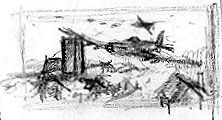
Next comes the research. This falls in to two categories, namely, the research I do myself, which is quite pleasant and usually involves a nice lunch somewhere or other, and the research which my little band of helpers carry out, and without whom I would be up the creek without a paddle more times than I care to think about. Thanks guys!
In all seriousness, the research is vitally important. Ensuring the aircraft have the right markings, the right equipment, that the backgrounds and sometimes even the weather are authentic is hugely time consuming and carries on throughout the work on the painting - for there is always some little detail that you want to add that then needs checking to ensure it's correctness.
Just thinking about the amount of time I, or my other researchers, have spent on the phone, finding out about coastal defences in north Cornwall, the make and colour scheme of a Suffolk bus during the 40's, or trying to find a photographic reference of the Sea-plane base at Sullom Voe just makes me want to reach for the tea-pot!
Still, eventually comes the day when, with the backbone of the research well and truly broken, it's time to 'make the model'. Naturally, it isn't always possible to get one if the aircraft is particularly obscure, but I always do my best to find one if I can. Without it you are left wallowing around, trying to imagine the angles and where the shadows would fall. It can be done but it really cuts into your tea and cakes time!
Now some people really like making models . . . .and that is all I have to say on that subject!
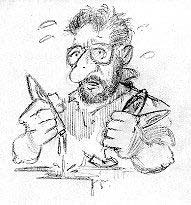
With the model made it is time to wait for the right lighting conditions so that it can be photographed. This is much easier than trying to paint straight from the model as it captures the light exactly the way you want it. This is always a pleasant way to spend an hour or two, outside in the garden, twisting and turning the model plane to find just the right play of light - except when it's the middle of winter and freezing cold, or the wind suddenly gets up and blows the carefully constructed plastic kit off the stand to deconstruct itself on the crazy paving!
But taking it as read that the tripod didn't blow over and smash the camera, the lens didn't drop off, I didn't open the back before rewinding the film, or that I completely lost interest in the idea, then the next stage is to find some suitable background reference.
The main idea for this particular picture was to be a Spitfire pilot's wedding with an unofficial flypast by one of the lads on the squadron. I'd already sounded out the idea with a couple of Battle of Britain pilots and they both thought the idea was OK, so having got the plane sorted out, the next job was to find a suitable village and church. I have to say that this part is seldom easy. I really don't know what people had in mind when they built these villages all those years ago - but it certainly wasn't people like me!
I really wanted to find a genuine location, and spent the best part of a month driving around the south of England looking for a suitable village. Corfe Castle was a contender for a while, but as with so many villages when viewed from above, it was far too higgledy piggledy to work in the way I wanted. I did have some nice cream teas though!
Eventually I came to the conclusion the only way to get what I wanted was to invent the background, and so, armed with photographs I'd taken around Ockley and a couple of other villages whose names I've since forgotten, I started work on the pencil sketch.
By now the summer was well and truly over and the work progressed much faster once falling asleep in the sun was no longer an option. All went swimmingly until I got to the church. This needed to be something quite small so as not to overpower the rest of the painting and, lo and behold, a perfect example appeared, as if by a miracle, in the form of a postcard from Dorset showing the church on Brownsea Island!
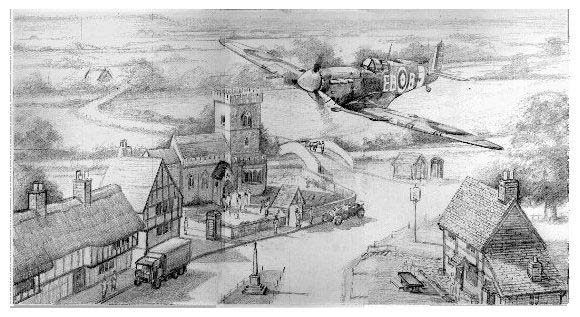
As you can see the drawing is quite detailed and was executed at the same size as the
intended print (12" X 22") or (305mmX560mm) according to your age and inclination.
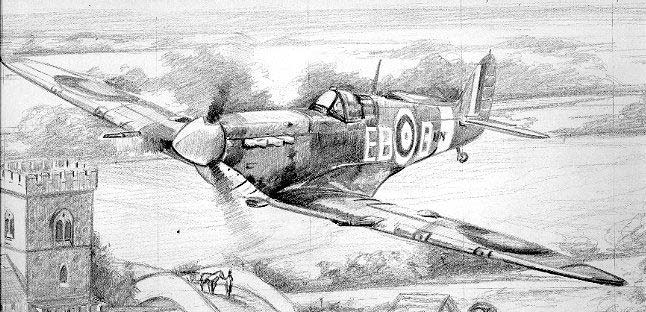
With the drawing completed, what's to stop that first daub of paint hitting the canvas? Well...quite a lot because we're not finished yet! Thinking how nice it would be to sit out on some hillside and knock up an abstract in an afternoon, I began the process known locally (well, amongst the members of my family, at least) as 'being a pain in the neck' (not actually the word used - but I have no desire to add to the obscenities on the Internet).
This ancient custom involves getting a good handful of photocopies of the finished drawing, some larger, some smaller, then cutting out bits and sticking them onto one of the many other copies. These hybrids are then presented to members of the family, friends, or anyone else who ventures into the house, with the words "Do you like this better?" To which the time honored reply comes, "I can't see any difference!"
This process, rather like such traditional pastimes as Morris Dancing and amateur dramatic society renditions of The Sound of Music, continues on well past the point of human endurance until finally I have brow beaten everyone into agreeing that the one with the slightly larger aeroplane, and the house on the left removed, and the woman with the hat shifted 5mm to right ... is undoubtedly an improvement........ maybe!
With the composition almost decided, another photocopy is made and this is used for the colour sketch. Although I paint the finished canvas in oils, the colour sketch is made in acrylic straight onto the photocopy. This saves having to draw up yet again a picture I am already getting heartily sick of - and the acrylic has the advantage of drying almost instantly and becoming completely immovable (as some of my best shirts will testify) allowing fresh paint to be applied over the top of the earlier coats with no risk of it turning to mud.
This colour sketch is made very quickly, taking no more than a couple of hours at most, but is quite invaluable when it comes time to start on the canvas.
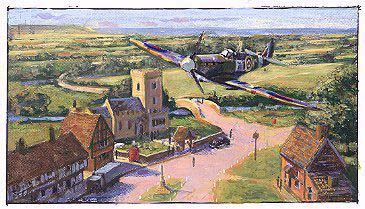
Because it is executed so quickly and loosely the colour sketch often has
a vibrancy and
immediacy that I never fail to lose in the finished picture.

Well....here we are! A great deal of thought - plus the combined efforts of the tea pickers of Ceylon and a battery of local bakers, and we are almost ready to put on that first oily brushstroke.....but not quite.
Having worked out in such detail exactly where everything is going there is little point in trusting to luck in transferring that small image to a 20" X 36" canvas .... oh no!
Out come the long rulers and pencils and off we go: first squaring up the canvas - then putting corresponding squares on the sketch - so that the image can be drawn in with an accuracy that William Tell could only dream of - first in pencil, then more permanently in brown acrylic.
With the main elements of the picture stained onto the canvas the moment has come and there is nothing more to do but to lay out the palette, put on the Vivaldi (No one helps you paint a sky like Viv) and off we go!......Easy, Huh?
Some weeks later the canvas is finished - or at least as finished as the original concept dictated. Now comes the evaluation. For this you will need a handy radiator (not turned on) on which to prop the painting. I know some smart alec artists use another easel - but what the hell do they know!
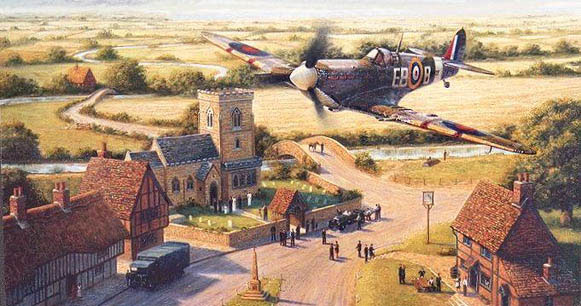
After some weeks - if not months - glancing over the finished picture during periods of idleness, I usually find a number of things that I don't like.
One of the things I really don't like is discovering that I don't like a major part of the composition and that the only way to fix it is to restart the picture from scratch. I have only ever had to do this once and I don't recommend it as a way of avoiding sun-bathing duties. In the case of this picture I came to the conclusion that the top left hand corner was exceedingly dull and that the village was overpowering the aircraft. Going back to the original sketch I tried adding a second aircraft and was pleased to see that placing a further Spitfire in that area not only livened up that part of the painting but also gave a greater emphasis and sense of speed to the main aircraft. Several smaller planes were then added in the far distance and, satisfied that all was well, tea and buns were ordered and off I went to work on my melanomas.
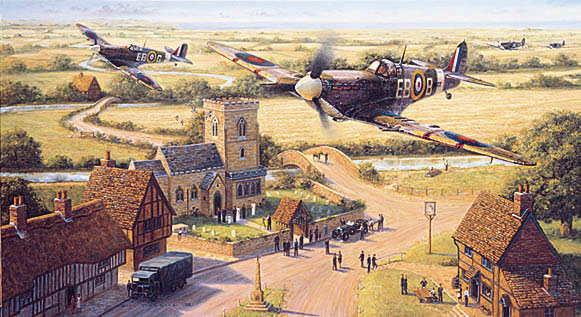
![]()
![]()
![]()
![]()
![]()
![]()
![]()